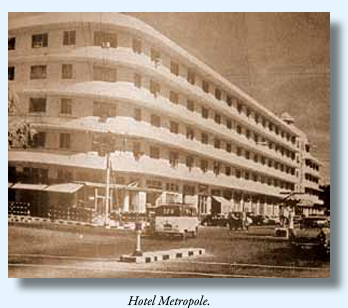Kaleemmullah Lashari, PhD, S I
Abstract
The Metropole hotel of Karachi came on the highest category of hotels in the mid of 20th century, which is no more functional now. T he Metropole Hotel was the one where every traveler preferred to stay as it not only provided short-term accommodation, which may be considered as its assigned role, but it was socially connected with the multifarious activities. It was sorted after by families as it offered different types of games and activities where families used to get involved. It was the place where the programs of Dancing, Musical events, programs, marriage ceremonies, etc were organized. There are various hotels in Karachi but most of the International Airlines had their glamourous offices around Metropole, besides that in the hotel there were Bookshops, a hairdresser, beauty shops, Gift Shop, Dry cleaners, and the post office also, it added value to the hotel. T he Metropole was used for the high-level meetings, workshops & Seminars. The Christian community had used this place for their events, there such as Christmas celebrators as well as we see their activities reflected in recollection of the senior members, one, in particular was held in the Hotel Metropole in the year 1956 T he paper discusses the heydays of Karachi and its hold Metropole. The article is mainly based on the material published in Daily DAWN Karachi. KEYWORDS: Karachi, Metropole hotel of Karachi, Hotel History, sedentary cultures.
Introduction
Interestingly the hotels are an important part of life, may these be the rural Inns or today’s newest concept of seven-star luxuries. These have been present since the early centuries of sedentary cultures. We have much-romanticized knowledge of the medieval period Inns, these be in the midst of the towns or be on the desolate highways, it has contributed much to the safety of the caravan goods and has provided solace to the scared wayfarers. T he hotels gradually and slowly grew with the expansion of civilization; these are not the only witness to the growth of the cities but had their part to play in the provisions of urban facilities. Of lately these have helped the megacities to shed-off their unbearable pressures and made life smoother for the luxury-loving, all too important dignitaries, not to abhor being away from the comforts of their homes, on necessary assignments, but rather look forward to undertaking the travel. It is playing its role of providing short-term accommodation, which may be its assigned role, additionally, it is knit-well in day toady life, and is directly related to the multifarious social needs. T he present-day hotels may have shed much of their basic role of providing the necessary shelter to the all too needy traveler, these have become the service providers of all sorts, be it the IT & Business Centre, Party place, hosting Banquets, operating Gyms, Swimming Pools, dating havens, arranging Conference/Seminar, and are no doubt nucleus to what not. T he hotels in Karachi have grown with the town; initially, the troops & officers arriving in the tiny town had the relief when they could secure births in the cantonment, officers’ Mess could be a great relief; the impression of new arrivals in Karachi was ‘not a bad place at all 1. Keith Young however narrated his encounter with Sir Charles Napier, when he was laid up with rheumatic fever ‘…looking certainly uncomfortable with a dirty blanket over him2. Since then, quite impressive progress was made, the growing town did keep pace breathlessly with the expanding British Empire. The Bristol Hotel was there to look after the Commuters of the North Western Railways, the Circuit House, located on the Brunton Road, looked after the Colonial Officials, and frequent spillover was accommodated in the Palace Hotel, situated nearby. The small landlords were comfortable in Sindh Zamindar Hotel and Jagirdar Hotel, the petit-bourgeoisie, and the working intelligentsia was satisfied with the Moulo Mussafirkhana, which was not at all a mean habitat. It was designed by the famous Architect of Karachi J. Strachan, he is introduced by Noorani as Architect of Empress Market, ‘James Strachan of Great Indian Peninsular & Bombay and Baroda Railways3. He in fact worked as Secretary of Karachi Municipality and its Engineer, the prolific architect, his contributions to architecture in Karachi are widely acknowledged,’ his water supply scheme and sewerage was the great contribution to the city;4 a plaque on old encroached building of the Mussaferkhana reads ‘the Dharamshala for poor travelers was built at the joint cost of Haji Mahammad Mouledina and Karachi Municipality, 1893, J. Strachan M.I.C.B. Architect.’ It subsequently became famous as Moulo-Mussaferkhana, with the shortened name of the government Contractor, who had partially contributed towards its costs. This building was an awe-inspiring sight; it can still be stunning if cleared of unwarranted encroachments.
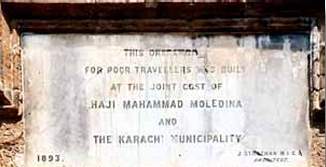
The massive destruction caused by the two great wars and the resulting economic depression proved to be a major setback to the travel business. The 1950s witnessed a slow and steady growth of travel on the European continent5 and also throughout the former areas under the British Raj. It saw the emergence of concerns for the quality of service. T he standardization and quality concerns made the experimentation possible, as the diversity in services and facilities provided by each hotel makes it quite difficult to have any single basis of classification of hotels6. These were the times when the world was already cherishing the inception of the modern hotels, those were not simply the rooms and dining halls. The hotel had come of the age, and it was throwing open the facilities of the diverse kind, previously not considered the essential part of the hotel7. T he newly independent country had some good investment opportunities opening up saw the inception of new business in the hospitality business. T he ‘government was anxious to develop a plan for the city of Karachi that was in keeping with its position as a capital of Pakistan (Hasan 1999)8. T his emphasis could be felt in matters where even the private enterprises were sympathetically looked at. One could see the names of the top brass on the plaques, denoting the laying of foundations stone, or the inauguration, of these private enterprises.

The foundation stone for Beach Luxury Hotel was laid down by the highest public office in the Province
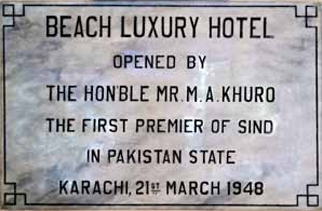
Beach Luxury was opened up the next year for the guests to stay, the opening ceremony was performed by the premier of Sindh, it is an indication of the importance this sector was accorded.
Karachi saw Beach Luxury and Metropole Hotels as a wonderful introduction to the cityscape. The unique and spacious location by the side of the creek, which had then not been the refuge of the city’s untreated sewer as yet was a life-infusing experience. The classical orders at the all-welcoming entrance of the Hotel Metropole were a very alluring site. The centrally placed hotel had all that was desired, a secure cozy interior, tasteful restaurant, reasonably furnished rooms, and a refreshing open central courtyard. Karachi at this time was described very well by an American Journalist, who happened to have stayed in East as well as West Pakistan, in one of her articles as “ a city of distinction with modern methods of communication and transport, offering the comforts of great western-style hotels, restaurants, night clubs, and sports facilities. A huge racecourse and clubs catering to tennis players, the swimming crowds and cocktail set”9. Karachi had six first-class hotels, the highest category to be assigned in the pre-5-star Hotel concept period, and the ‘Metropole was the largest of all’10. It had beautiful rooms to accommodate five hundred guests. Air conditioning was in, as the required facility here. If we look at the accounts there is not much information about the Metropole; a wonderful essay on Saddar of the fifties and sixties11 gives an overview of the Saddar and its atmosphere, its physical landmarks, but understandably nothing is said about the hotel we are discussing here. Likewise, the fine work Understanding Karachi, by Arif Hasan informs us about the city and its development, the hotel is obviously cannot find its mention there12. A lively account of Karachi of these decades is by Ramzan Baloch, he describes the tendencies of socializing among young men having leanings towards left, he too is short of getting in and describing the atmosphere there13. To have a feel at the pulse of the times we turned our gaze to one of the dailies from Karachi; it brought us in contact with the hotel Metropole, as it was perceived, one of the writeups described it as the complete world in itself where the alluring flower ring grounds provided the green setting, people can dine in the night under the stars, and an orchestra played for dancing, at no extra charges14. Most of the International Airlines had glamorous offices around Metropole Hotel15; in the hotel there was the excellent Bookshop, a hairdresser, beauty shop, gift shop, dry cleaners, and Post Office, besides the Lloyds Bank and two Chemists16. The Canadian High Commission occupied almost half of the second floor. There were Doctors and dentists of renown; few of them lived there. Interestingly sometimes they had room for the tourists. There were numerous other offices. T he gentle Minwalla spent more time here than at his home, he was very mindful of the comfort of the guests, his motto seemed to be how to keep everyone happy, the highest flag to hoist in the service industry17. T he charming staff was eager to serve, they went out of their way to set standards of high service, polite but rigidly entrenched in the values of their folks. The rates started at rupees 33 for charges per day, allinclusive, the Hotel Beach Luxury matched these; while the Palace, Central, Columbus, and Excelsior had rates starting from rupees 18 per day.
The area atmosphere could be described with modesty as the dream world, in the next block there was a beauty shop with John taking care of the needs, Tailor Shop, and PIA Head Office, where the booking staff was efficiently taking care, ‘without wearing veils’. Beautiful Frère Hall surrounded by the immense gardens was at that time housing the National Museum. It contained valuable artifacts, very important Buddhist sculpture pieces, giving a fairly good idea of the cultural richness and diversity of Pakistan. Victoria Road opened up the Bazars matching the ones in Arabian Nights, “please step in for Original Persian Rugs…..here come to see the Brass…. ” was the routine hum18. APWA outlet brought the simple utility and beauty of embroidery to the attention of the pedestrians. The Bohri Bazar streets crisscrossing were home to all poorest of all and the rich, all vying with each other to have the colorful bangles, articles studded with the stones, shells, and Damascened to provide the oriental touch19.
THE HOME TO MUSIC & DANCE
T hings were happening, the music was becoming international, various bands were traveling, concerts were the new attractions, and these were not required to go to the Garrison Authorities for seeking the venues for performance. The Military had its days of Brass and Bagpipes and with swollen chests full of a sense of self-importance they needed nothing more to offer. The private bands were sufficiently busy to provide the entertainment to the wedding and circumcision functions. The world was seeing the inception of novel trends, artists’ commitment, and their trendy performances were internationally acclaimed. The newspapers were running regular columns covering the last evenings’ performances. The announcements were also substantiated with the reference in the Engagements slot of the newspapers. Guess where these performances were happening? Metropole was the prime venue, the best artists from all over the world were coming to Karachi and giving the best of their performances.
Social Scene
T he social scene presents a very involving Hotel Metropole, the Idd Gala was one attraction organized by the house, and could be attended by booking or otherwise by showing up, subject to availability of the table on that day, that might not happen as Ami was to present her ‘Oriental Dance’ that was titled as “Into & Marlene”20. Mike was there with these latest compositions, the booking could be done on phone, and everyone knew the number of the hotel 6051 by heart.
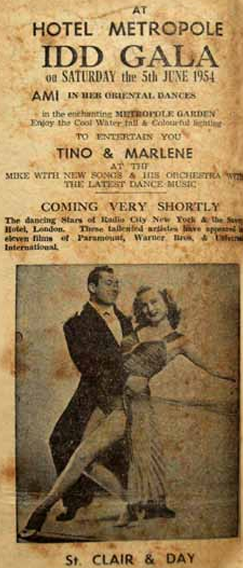
Advertisement Published in Daily DAWN, 1 June 1954, p. 8
The occasion required due courtesy as well, Evening or National Dress was essential21. The performance was a great success; the weekend (Saturday, 5 June) was memorable.
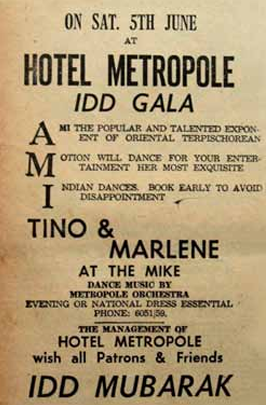
Advertisement Published in Daily DAWN, 3 June 1954, p. 14
It was not all, on 10th June came the Stars of Radio City, New York and the Savoy Hotel, London St. Clair and Day, to perform for next few days, they were the film stars also22.
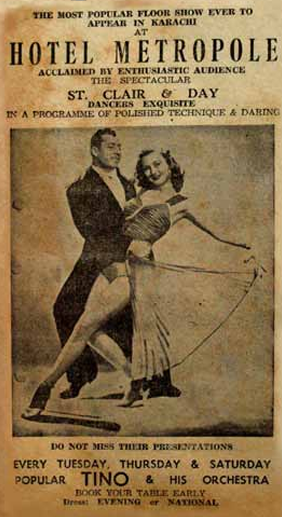
Advertisement Published in Daily DAWN, 8 June 1954, p. 8
This was the most popular of all ‘Floor Shows’, which had happened in Karachi, till that time23,
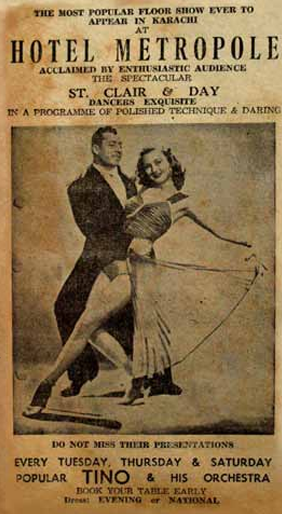
Advertisement Published in Daily DAWN, 15 June 1954, p. 8
the audiences were most enthusiastic in their appreciation24. The artists then changed the theme of their performance in the next few performances25.
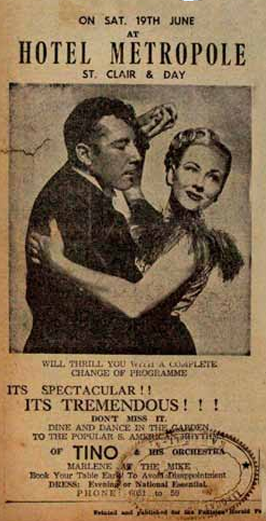
Advertisement Published in Daily DAWN, 19 June 1954, p. 8
The different professional bodies, work associations, social groups, etc. were eagerly waiting for the occasion to go active; here was the place to be most sorted after, with the beautiful waterfall and airy garden. The Calcutta Association’s Idd Reunion was a regular event, in the year 1954 on Iddul-Fitre they once again met in the garden of the Hotel at 5.30pm26 and the sitting lasted for three hours.

Advertisement Published in Daily DAWN, 2 June 1954, p. 4
Social Circles
The Mackennon’s Staff Welfare Association ReUnion27 followed them at 8.30 pm; they sat longer and were happy as it was a weekend.

Advertisement published in Dawn, by the Mackinnon’s Staff Welfare Association.
Federal University Student Association organized their Re-Union on 21st June in the late afternoon. We hear that in the subsequent years to this Association was active and remained committed to upholding the same high standards of arrangements, in the year 1956 they organized the Idd Re-Union on 119th July in the late afternoon. Mr. Wahab Siddiqui, Mayor of Karachi was the Chief Guest28 they organized a Variety Program on August 4th, the event was a great success as the Pakistani dances were performed, many members of the foreign embassies also performed folk dances, the regional songs were quite popular. We see them returning very soon to organize another ‘Variety Program’ on 7th September 1956. The event was scheduled for 6th but was changed to 7th presumably to accommodate more entertainment. Karachi Cine Exhibition Association was the most active organization with much entertainment up their sleeves, their Annual function happened on 1st July, understandably late in the evening29.

Advertisement Published in Daily DAWN, 29 June 1954, p. 4
There were other social groups involved in softening the hard routine of daily life; wasn’t it exciting and also enticing enough to get the more serious and business like Jamsheed Nusservanji Memorial Fund Committee to be there as well. The fund organized a variety program on Nov 20, 1054, the one that was remembered long afterward by those who happened to have seen the Spanish Fiesta Trio. Come December there were festivities related to Christmas, the Hotel’s Christmas Week Programs were studded with small and big events, culminating the Christmas Eve Gala. Children’s Christmas Party was another regular feature, participated by the young children not over the age of 12 years that included fancy dress competition also. Santa Claus cannot be missed, he being the one dispensing the gifts, to fulfill his responsibility. Miss Eileen Cromer was also there to play her part in the programs. Amazingly the sports were not forgotten in such festivities, the 26th December saw a great deal of talent in the big Boxing Day event. The Cuban bar curiosities were not to be missed when the Cuban Tropics were reflected very loudly in the Cuban Music evenings. The festivities of the New Year celebrations were over, that was the time when more serious works were undertaken. The Photographic Society of Pakistan organized the 1st joint exhibition of Photographic Arts of Great Britain and Pakistan, for which the Royal Photographic Society of Great Britain had collaborated30. The contest and crowning of the Miss Airways 1959 was a big event, the Aero News organized it, at the Hotel on 4th February. The celebrity of the Piano Music Peter Cooper visited Karachi and performed at Karachi; the pianoforte recital enthralled the audiences on the late evening of 5th March 1959. The Japanese interests were getting more visible in the sixties; the visiting Trade Delegation was entertained in Hotel Metropole, on 8th February 1967. Another body, that was very active on the social and literary scene was the Advertisers and Publishers Club, they organized the monthly dinners. In one such dinner outstanding scholar and the staunch supporter of Urdu Dr. Moulvi Abdul Haq also spoke31.

Advertisement Published in Daily DAWN, 28 Nov 1954, p. 8
Art Scene
The painters and the artists were other phenomena of modern-day life, Karachi had suffered greatly for the lack of any art school, it has neither the gifted artist of its own nor the business was such that required the flourishing painting business, the only avenues available were Cinema signposts and the printmaking, that was used in the print business. The emerging painters were the direct result of the colonial experience; thus a great new happening was there, but how could this experience be shared? The city had no art galleries, no studios of sufficient space to accommodate ten-odd canvasses with reasonable spacing; look what a lovely outlet was made available, by the suitably situated Hotel Metropole. Dance is rightly dubbed as the soul’s way of performance, expression of ecstasy, the ultimate show of the body’s harmony with the soul, and an experience to be shared so easily with the audiences. But was there a venue available to bring the performers and the audiences together?
The Parties
The Shamiana was still the mainstay of the community, all important events were there getting the feel of the street, afflicted with the physical limitations, the guests were graciously adoptive to these conditions, but the hosts were always mindful of these, often embarrassed they were anxiously awaiting the solution of this problem. That was the reason many family events, with sizeable participation, were held at the Hotel. Zahid Sahib’s family functions were held here, he was the Governor State Bank. Mr. Justice Nasir Aslam Zahid fondly recalls the wedding of his brother, the Valima party took place there, on 26th August 1954; as a custom, almost all the bigger events were held at the hotel.

Diplomatic Scene
The hotel was the station where many diplomatic corps’ activities were taking place; the German Reading Room was the predecessor of the Goethe Institute here. It organized activities regularly on diverse topics, mostly cultural and academic. The performances and programs were on diverse topics, covering different fields, on 4th July the Botanical Films were screened at 7.30 pm; this event was of special value as it reflected the great potential of the research and its presentation in the field.

The next event on 25th July was the interesting recording of the music by Robert Schumann. Mr. Kahle introduced it. August 8, 1956, there was a good talk on the Research related to Islam in Germany. On 12th followed Dr. Schrelterer’s talk on Technical Education and Training in Germany, at 7.30. T he Light Music from Berlin was the focus of the next event at the Reading Room, on Wednesday, September the 5th.

The next lecture by W Krieg was very interesting as it covered the Industry of German Motorcycles, it was held on 26th September 1956.
The Reading Room was one of the most frequented places, as it covered diverse topics and helped open the new grounds of knowledge and understanding regarding the German Society and its culture as well as economic development. Every Wednesday there was an event, be it the music, movie, lecture, or exhibition. This also provided the platform to the German Language Association, which was an active body, organizing language classes, having activities like trips and parties, welcoming or bidding farewell to the teachers/guests etc. In the year 1958, we saw quite a good number of German movies screened at the Room; one such was held on 2nd July.

It was the Annual Dinner of the Pakistan German Forum on 25th July same year, which was followed by the General Body meeting. The Forum was most active and it involved a good number of the businessmen and also the high officials; we know that many events were organized by the Forum, one such took place on 12th August 1959 in which Mr. Mumtaz Hassan gave a very absorbing talk; he spoke about his experience during the visit to Germany, he at that time was the Deputy Chairman of the Planning Commission of Pakistan.
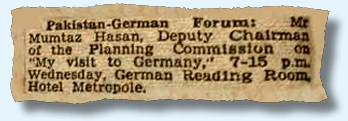
The embassies were mostly vying for the venue, the “Fall of Bastille”, the National day of France, falling on 14th of July was celebrated, in the year 1956, in the Hotel, the program was largely attended, the Begum and the President of Pakistan Sikander Mirza, Mrs. and Mr. I.I Chandrigar and others. The elite of the city was prominently represented. Due to weather uncertainty arrangements were made to lead the guests through the back entrance.
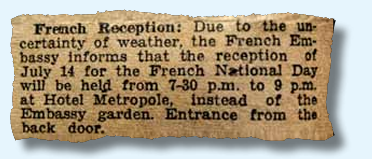
T he Polish Trade Commissioner held the reception on the occasion of the Liberation of the Polish People on 22nd July 1956. The visiting Czechoslovak Business delegation was entertained on Tea in the garden of the Hotel, on the 8thAugust 1956. Again a local businessman entertained the delegation at a party on 11th.

It is an endless list of happening every year, the life of Karachi revolved around the Hotel, and those who attended these events, be it entertainment, social gathering, business-related meeting, group association, hobby club, diplomatic event, lecture, film screening, art show, Idd or Christmas celebrations, weddings or any other happening had a clear memory of that happening, the experience remained with them; it was the part of their living memory, and still, it is there. It experienced Karachi, related to the everyday life, the essence of living in an urban setting, sharing an experience without falling into any category, individual yet a cumulative experience that is cherished as living in the emerging metropolis.
Conclusion
To peep back in times, the newspapers can be a relevant source of information, in many cases; the present writeup has proved it in the case of a commercial hotel, operating in the city of Karachi. It was a fit case where the elite, middle class and the lower middle class could gather and participate in multi-pronged activities. The imaginative and business-minded management was alive to the emerging civic needs, for which space was provided on a commercial basis. In the present case, we saw the emergence of a new type of hotel, which had space for every conceivable social activity. Resultantly the picture emerged, which helps the reader to have glimpses back in time and can follow the dynamic vibes of the fifties to early seventies, in the emerging megapolis of Pakistan.
Bibliography
1 Arif Hasan, Understanding Karachi: Planning & Reform for the Future, City Press, Karachi, 1999, & 2002, p.25.
2 Asif Noorani, ‘Saddar of fifties and sixties,’ in Karachi: Mega City of Our Times, Hamida Khuhro, & Anwar Mooraj (eds.), 2011(2nd ed.)
3 Camille Mirepoix, published her impressions of the Hotel Metropole in an article in Daily DAWN, Karachi, in 1959; it was later part of her book Now Pakistan, Grenich Books, Karachi 1967, pp. 28-31
4 Colonel Keith Young, Scinde in the Forties, Indus Publications, Karachi, 1994 (Reprint), p.7)
5 Daily DAWN, Karachi, Various issues of the newspaper, as reflected in the references & notes.
6 Hotel rating, From Wikipedia, the free encyclopedia; accessed on 25 March 2021;
7 Ramzan Baloch, Lyari kee un Kahee Kahanee, Raheel Publications, Karachi 2017, p.182].
8 Tourismnotes.com (accessed on 28th March 2021)
9 Types of Hotels, January 22nd, 2020|tourism
References
1 Colonel Keith Young, Scinde in the Forties, Indus Publications, Karachi, 1994 (Reprint), p.7)
2 Ibid p.12-3.
3 Asif Noorani, ‘Saddar of fifties and sixties,’ in Karachi: Mega City of Our Times, Hamida Khuhro, & Anwar Mooraj (eds.), 2011(2nd ed.)
4 Ibid, p.243
5 tourismnotes.com (accessed on 28th March 2021)
6 Hotel rating, From Wikipedia, the free encyclopedia; accessed on 25 March 2021;
7 Types of Hotels, January 22nd, 2020|tourism
8 Arif Hasan, Understanding Karachi: Planning & Reform for the Future, City Press, Karachi, 1999, & 2002, p.25.
9 Camille Mirepoix, published her impressions of the Hotel Metropole in an article in Daily DAWN, Karachi, in 1959; it was later part of her book Now Pakistan, Grenich Books, Karachi 1967, pp. 28-31
10 The Intercontinental Hotel opened its operations in Karachi by 1964; Ibid, p.25
11 Noorani, ‘Saddar in fifties and sixties,’ in , Karachi: Megacity of our Times, Hamida Khuhro, & Anwer Mooraj (eds.), Oxford, Karachi 1997 & 2010, pp.241-257
12 Arif Hasan, 1999.
13 Ramzan Baloch, Lyari kee un Kahee Kahanee, Raheel Publications, Karachi 2017, p.182].
14 This picture emerges from various advertisements, appearing in Daily Dawn, Karachi sees various references hereafter; also, Mirepoix, referenced hereabove.
15 The number of the advertisements appearing in Daily Dawn, Karachi.
16 Mirepoix, p.32.
17 Ibid p.29.
18 Ibid, pp.39-40.
19 Ibid, p.40.
20 Advertisement Published in Daily DAWN, 1 June 1954, p. 8
21 Advertisement Published in Daily DAWN, 3 June 1954, p. 14
22 Advertisement Published in Daily DAWN, 8 June 1954, p. 8
23 Advertisement Published in Daily DAWN, 15 June 1954, p. 8
24 Advertisement Published in Daily DAWN, 17 June 1954, p. 8
25 Advertisement Published in Daily DAWN, 19 June 1954, p. 8
26 Advertisement Published in Daily DAWN, 2 June 1954, p. 4
27 Advertisement Published in Daily DAWN, 3 June 1954, p. 6
28 The Karachi University Old Student Association was not lagging behind, we see their activities reflected in recollection of the senior members, one, in particular, was held in the Hotel Metropole in the year 1956.
29 Advertisement Published in Daily DAWN, 29 June 1954, p. 4
30 Advertisement Published in Daily DAWN, 25 Jan; 1959, Karachi, p.6
31 Advertisement Published in Daily DAWN, 28 Nov,

